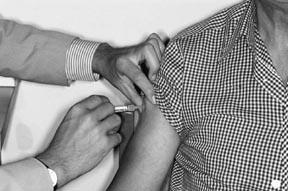U of C injects advice on flu shots
<<< Back to Vaccines
study affects of flu vaccinations
by Alex Frazer Harrison
 Clinical trials can be a slow process. It can take months to
organize the research and analyze the results.
Clinical trials can be a slow process. It can take months to
organize the research and analyze the results.
So what happens when you need to conduct an urgent
safety study – and you only have six weeks in which to
collect the data and analyze it?
That’s what the Canadian Association for Immunization
Research and Evaluation (CAIRE) faced when it was called
upon by Health Canada to conduct clinical trials to gauge possible
side-effects of a flu vaccine.
Several U of C researchers were involved in the
ground-breaking 2001 study.
“
In 2000, it was noticed that a higher number than usual
people had reported side effects after getting flu shots, including
red eyes and tightness in the throat (oculorespiratory syndrome),” says
Dr. Margaret Russell, an associate professor in the
Department of Community Health Sciences in the Faculty of Medicine.
The side-effects were traced to a change in how
one of Canada’s flu-vaccine makers manufactured the drug in
2000. That company made the correction, but in order
to ensure the vaccine set to go out in the fall of 2001 was
safe, a clinical
study had to be done fast, Russell says. “
Participants had to be found, screened and treated – in
just four weeks.”
The results of both studies were recently published
this year in the journal Clinical Infectious
Diseases.
But the data needed to give the 2001
vaccine the go-ahead was ready within the
six week
deadline.
“
We found that the vaccine was safe (but) some people
do have adverse reactions,” Russell says. “Our findings
will help make health care providers and the public
more aware that the vaccines are safe but some aches and headaches
could
be expected.”
The findings, published in October 2003,
suggests those who have experienced adverse
effects from flu shots in the past
should check with their doctor, but reported
reactions were generally mild and are
not a
barrier to people
being vaccinated
again.
“
In our first trial of people who had not suffered effects
before, no one was bothered enough by side-effects to seekmedical
attention,” Russell says.
In the long term, Russell says, the
fact CAIRE was, in such a short period of
time, able to recruit and screen hundreds
of test subjects
from across Canada,
gather
data, and draw conclusions,
will bode well the next time an urgent
study
of this sort is needed.
“
We know that if necessary we will be able to do the
necessary safety testing (in a short period of time),” she
says. “The lessons learned from doing this study will
be incredibly important.”
Other U of C faculty involved in
the study were Doctors H. Dele
Davies, James Kellner and Judy MacDonald.
Back to top of Document
|